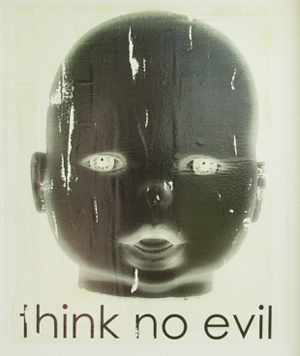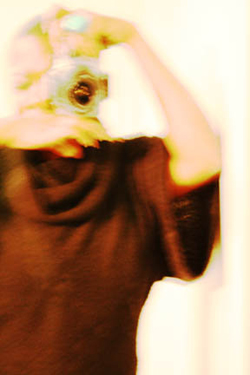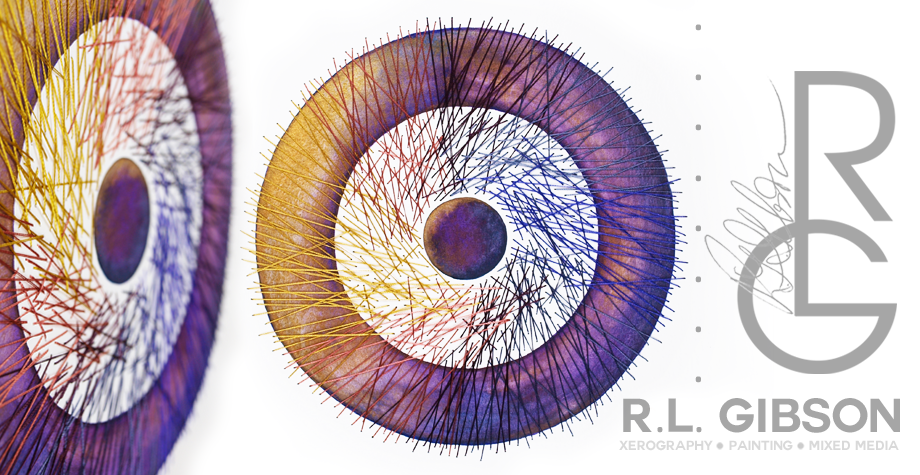As an homage to the new interactive R.L. Gibson site, I thought we could all take a little trip down memory lane with some work from the past. Speak No Evil is not my favorite series to date; however, it is a step in my development as an artist that I cherish. Enjoy!
 Speak No Evil, 2006 – 2007
Speak No Evil, 2006 – 2007
Artist’s Statement: “I am an Objectivist–that is, I believe in objective reality. I believe that words have meanings, and I enjoy the debate that asks, ‘Who defines a language?’ Is a language–be it written, spoken or aesthetic–defined by the user or some other hierarchy of trusted caretakers? And why are people often offended by truth–not the ugly, hurtful truth, but the sky-is-blue truth? How does context change definition and intention? My work explores these questions. I’m not ceratin the answers are clear to me although I do not doubt the existence of the objective truth of the answers–an odd sort of faith from a distinctly unspiritual woman.
“I am deeply influenced by my role as a southern born and reared woman. I have a great love of southern language with all of its innuendos, euphemisms and passive tones that mak a long history of eccentricities, unpopular opinions and niceties. I ws spoon-fed ‘If you can’t say something nice…’ but it wasn’t well digested. Does the adage ‘Hear No Evil, See No Evil, Speak No Evil’ function without ‘Think No Evil?’ This body of work juxtaposes exasperatingly high moral standars against the public question of excruciatingly low moral fortitude and asks, is ‘Speak No Evil’ an acceptable substitute for ‘Think No Evil?’ while posing the personal queston ‘Am I a truth teller?’ or just not a ‘Well-Behaved Woman?’ ” –R.L. Gibson
Click below for a slideshow of Speak No Evil.
See the what critic Michaela Pilar Brown said about Speak No Evil:
“In this series of xerographic prints, Gibson challenges patriarchal conventions about truth, morality, and freedom in a culture increasingly driven along a path to homogeneity, and a return to the exclusion and marginalization of unpopular opinions and ideas. Gibson employs the use of text throughout these images to call attention to the use of language.
 “Words attached to art imbue meaning and effect interpretation often more powerfully than images alone. It musts be noted that Gibson makes use of the red editor’s pen. The images are simple, and words are used with brevity. Challenging large ideas with such an economy of words and simple images leaves room in Gibson’s work for both comic relief and austerity.
“Words attached to art imbue meaning and effect interpretation often more powerfully than images alone. It musts be noted that Gibson makes use of the red editor’s pen. The images are simple, and words are used with brevity. Challenging large ideas with such an economy of words and simple images leaves room in Gibson’s work for both comic relief and austerity.
“Her use of text is both a nod to its literary origin, and a subversive tyrannical act, to make the viewer question both meaning and use in a broader context. In the work ‘Such a Pretty Face,’ Gibson addresses the notion of hiding criticism in a compliment. It begs the questions, in a postmodern world, a world of rapidly exchanged text, ticker tape, and irretrievable digital burps, who owns the language? Can words live in static form? Do they evolve? When are they weapon, propaganda, song?
“In the triptych ‘See, Hear & Speak,’ Gibson addresses the notion of turning a blind eye to evil. It is an image and phrase familiar to most Americans, so familiar in fact that the phrase ‘see no hear no speak no evil’ conjures images of a monkey covering its eyes, mouth and ears and the reverse. A doll’s head has replaced the monkeys. This simple change destroys the kitschy-ness of the image, and presents a more human question. The doll’s head floating against a flat background robs it of its innocence. By ignoring evil are we not responsible for its growth?”
–Michaela Pilar Brown, 2007 as Director of Gallery 107 North


Rachel, let’s do something soon. Working on a new group of paintings, think you can arrange something in your neck of the woods. I’m thinking we can tag team, I’ll write about your work you can write about mine.